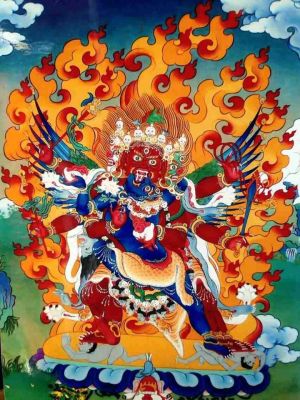Difference between revisions of "Chöd (severance, cutting"
| Line 1: | Line 1: | ||
| − | + | [[File:190925.jpg|thumb]] | |
| Line 9: | Line 9: | ||
specific, dangerously "[[magical]]" [[rituals]] on the other, it has often been conveniently "forgotten" when {{Wiki|speaking}} of the various [[Tibetan schools]] and has long received little [[attention]] in [[Western]] works about [[Tibetan Buddhism]]. | specific, dangerously "[[magical]]" [[rituals]] on the other, it has often been conveniently "forgotten" when {{Wiki|speaking}} of the various [[Tibetan schools]] and has long received little [[attention]] in [[Western]] works about [[Tibetan Buddhism]]. | ||
| − | The [[Tibetan]] [[gCod]] translates as cutting, severing and/or dismemberment, terms to be understood mainly in a [[symbolic]] and/or [[psychological]] [[sense]] (as a radical [[liberation]] from one's [[ego]] and all that it usually {{Wiki|fears}}). However, to a [[Tibetan ]]- in a {{Wiki|culture}} in which the deceased were actually left on a [[charnel ground]] | + | The [[Tibetan]] [[gCod]] translates as cutting, severing and/or dismemberment, terms to be understood mainly in a [[symbolic]] and/or [[psychological]] [[sense]] (as a radical [[liberation]] from one's [[ego]] and all that it usually {{Wiki|fears}}). However, to a [[Tibetan ]] - in a {{Wiki|culture}} in which the deceased were actually left on a [[charnel ground]] |
and their [[bodies]] cut up and fed to vultures and other {{Wiki|carrion}} [[animals]] such [[visions]] of dismemberment also represent a "soon to come" [[reality]]. | and their [[bodies]] cut up and fed to vultures and other {{Wiki|carrion}} [[animals]] such [[visions]] of dismemberment also represent a "soon to come" [[reality]]. | ||
| Line 19: | Line 19: | ||
The school of {{Wiki|male}} [[Chöd]] was founded by sKyo [[Sa-skya]] [[ye-shes]] (11th century [[student]] of [[Phadampa Sangye]]). The other, {{Wiki|female}} [[development]] of [[Chöd]] is based in the teachings of the unique and fascinating [[Machig Lapdrön]] (1055-1145), the [[Dakini]] [[Guru]] of this [[lineage]] and an [[incarnation]] of [[Yeshe Tsogyal]]. | The school of {{Wiki|male}} [[Chöd]] was founded by sKyo [[Sa-skya]] [[ye-shes]] (11th century [[student]] of [[Phadampa Sangye]]). The other, {{Wiki|female}} [[development]] of [[Chöd]] is based in the teachings of the unique and fascinating [[Machig Lapdrön]] (1055-1145), the [[Dakini]] [[Guru]] of this [[lineage]] and an [[incarnation]] of [[Yeshe Tsogyal]]. | ||
| − | |||
Latest revision as of 10:12, 18 December 2020
One of the Eight Great Chariots of the Practice Lineage, Chöd is somehow an independent 'school' - though often classed together with Shijed - but its teachings are practiced by adepts of many other schools at the higher stages of the Inner Tantras. Because of Chöd's esotericism on the one hand, and its
specific, dangerously "magical" rituals on the other, it has often been conveniently "forgotten" when speaking of the various Tibetan schools and has long received little attention in Western works about Tibetan Buddhism.
The Tibetan gCod translates as cutting, severing and/or dismemberment, terms to be understood mainly in a symbolic and/or psychological sense (as a radical liberation from one's ego and all that it usually fears). However, to a Tibetan - in a culture in which the deceased were actually left on a charnel ground
and their bodies cut up and fed to vultures and other carrion animals such visions of dismemberment also represent a "soon to come" reality. In a typical Chöd ritual, the practitioner - equipped with a damaru and a trumpet of human thighbone visits a charnel ground visualizing the "cutting up" and
offering of his or her body, a rather universal shamanic trance practice during which the adept's body is disassembled into pieces which, if all goes well, are later re-assembled once again by divinities, demons and similar entities from the beyond.
As a whole, Chöd was inspired by the teachings of the Indian adept Phadampa Sangye (c. 1045-1117), and its adherents regard the Prajnaparamita Sutra as the school's most important sacred text. A certain distinction exists between pho-gCod (male Chöd) and mo-gCod (female Chöd), indicating two strands of the lineage.
The school of male Chöd was founded by sKyo Sa-skya ye-shes (11th century student of Phadampa Sangye). The other, female development of Chöd is based in the teachings of the unique and fascinating Machig Lapdrön (1055-1145), the Dakini Guru of this lineage and an incarnation of Yeshe Tsogyal.
